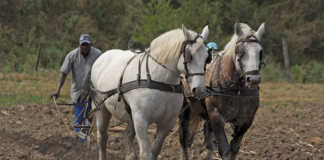When checking a chicken’s health, start by examining its general appearance.
Does it seem healthy? It is walking about, seeking food and looking for shelter during cold or very hot weather? Or is it sitting alone and looking puffed up? Are hens laying eggs regularly? Are the chickens the same size, or are some smaller than others?
Then, pick up each chicken to check its general condition. Feel the muscles around the breastbone – if it’s healthy, the muscles will cover the breastbone. If the breastbone “stands out”, with little muscle cover on each side, the chicken may be sick, hasn’t been eating for a while, or it’s not getting enough food.
Next, look at the different body parts from head to tail:

When checking a chicken’s health, examine its body from head to tail, following the eight points shown here.
1.Comb/wattles: A healthy chicken’s wattles and comb should be red. Blue or black isn’t normal. And there should be no cuts or swelling.
2. Eyes: A sick chicken’s eyes are usually an oval shape and a dull white colour. They may also be closed if there’s a discharge of thick fluid.
3. Nostrils: Just like a human, a chicken can have a blocked nose. That is, fluid coming out of the nostrils can cause “crusts” that block the opening. When this happens, the chicken will breathe with a “snoring” sound. Also, the space between the eyes and the nostrils (sinuses) shouldn’t be swollen.
4. Beak: There shouldn’t be any parts missing, and the beak shouldn’t feel soft and rubbery. But keep in mind that some suppliers trim the top part of the beak to prevent layers from pecking each other in the cages.
5. Neck: Should be strong and straight, not weak and twisted.
6. Feathers: Feathers protect chickens against extreme temperatures and should cover the whole body. But in some indigenous breeds, the neck and chest may be bare. Feathers normally lie flat against the body. They only become “raised” in cold weather, when the chicken sleeps, or when it’s sick. Feathers should be clean. Dirty feathers with droppings around the vent may be a sign of diarrhoea. Also, check between feathers for ticks and lice. Ticks are usually found around the head and lice on the feathers of the neck and wings.
7. Legs: Should be strong, straight and smooth, with a yellow colouring. There shouldn’t be any cuts or swellings, and the chicken should walk normally without limping.
8. Tail and vent: Should be clean and feathers should be soft and fluffy. If the area is swollen, that could mean an egg can’t pass. Caked faeces could be a sign of diarrhoea.
What to do next
Separate sick chickens from healthy ones and get advice from a vet or animal health technician. Before buying chickens, also use this checklist to select only the healthy ones.
- Factors that could cause disease
- Poor quality food and water.Poor hygiene and cleaning, leading to a build-up of chicken droppings.
- Leaking water bowls.
- Rat and fly problems.
- Overcrowding.
- Chickens of mixed ages reared together.
- Too hot or too cold conditions.
- Wet litter.
- Poor condition due to underfeeding.
- No vaccinations.
Keeping them healthy
- Use good quality food and provide clean water daily.
- Use bedding that isn’t dusty.
- Ensure that no one outside your farm visits the chicken house.
- Have bird-proof houses to keep out wild birds that eat the chicken feed and bring diseases into the chicken house.
- Houses must be warm in winter, cool in summer and well-ventilated.
- Laying-hen cages must not have sharp edges that can injure the hens.
- Ensure there’s enough space per hen.
- Get only first-grade chicks from a good, reliable supplier.
- Vaccinate chicks against diseases.
Source: Are My Chickens Healthy? by AJ Olivier, Directorate Communication, national agriculture department, in co-operation with the Agricultural Research Council (ARC)-Onderstepoort Veterinary Institute.
| Problem |
Signs |
Causes |
Treatment | |
| Diarrhoea (loose, watery droppings). | A chicken with diarrhoea may also: • Show poor growth. • Not be eating, drinking or moving around. The intestines of a chicken that has died (after showing these symptoms) may be red and swollen and the contents watery. |
Bacteria such as Salmonella or E. Coli. • Viruses such as Newcastle disease. • Parasites (worms). • Fungi such as Candida and Aspergillus. |
A vet will recommend an antibiotic that must be mixed in the chickens’ water for three to five days. Electrolytes, vitamins and minerals can also be added to help chickens recover. | |
| Upper respiratory tract disease | • The area between the eye and the beak is swollen, and eyes are closed. • Wetness around the eyes and nostrils. • Sneezing, coughing and difficulty breathing. • Weakness and loss of appetite. • In dead chickens, the windpipe and throat will be red. |
Bacteria. • Viruses such as Newcastle disease, influenza and infectious bronchitis. |
Again, a vet will recommend an antibiotic that must be mixed in the chickens’ water for three to five days. Electrolytes, vitamins and minerals can also be added to help the chickens regain their strength. | |
| Nervous signs or lameness | Nervous signs: • The chicken may seem disorientated. • It may be pulling its head and neck over its back. Lameness: • The chicken may be lying down constantly. • It may be walking with a limp. |
• Bacteria. • Viruses. • Fungi. |
Your vet should help you plan a complete hygiene and disinfection programme. Antibiotics will only be effective against bacteria and must be used as recommended. | |
| Newcastle disease | Sudden death amongst your flock without any obvious cause. | • A very contagious virus. | If your chickens have it, don’t visit other chicken farmers without washing and putting on new clothes and shoes. There’s no treatment, so prevent it by vaccinating your flock. Stop it from spreading in your flock by immediately slaughtering chickens with the disease, thoroughly cleaning the chicken house and all equipment, and burning litter and dead infected chickens. | |
| Drop in egg production | • Hens aren’t producing as many eggs as they should for their age. • Unusually-shaped eggs, eggs with no shell, soft eggs, eggs that break easily, or eggs with abnormal content when you break them open. • Often, people buying your chicken eggs will complain of poor quality. • The only way you will notice these signs is if you keep good records. |
• Parasites. • Bacteria such as E. Coli and Salmonella. • Viruses such as Newcastle disease, influenza, infectious bronchitis and egg drop syndrome, where the hen lays thin-shelled or shell-less eggs. |
Your vet or animal health technician may recommend a short course of antibiotics for bacterial infections. Adding vitamins and minerals to the water or feed may also help. | |
| Source: Animal Health for Developing Farmers, ARC-Onderstepoort Veterinary Institute. |
||||













